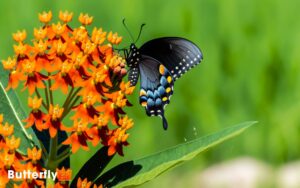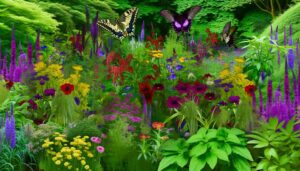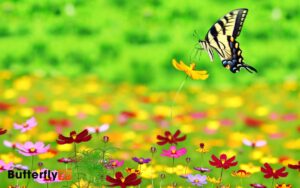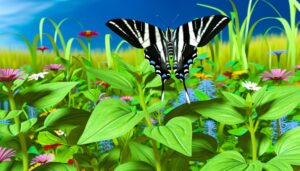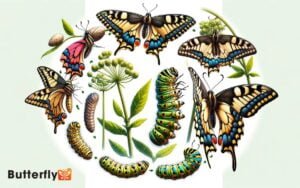Three Stunning Swallowtail Butterfly Pictures
The Swallowtail Butterfly, belonging to the family Papilionidae, encompasses approximately 550 species characterized by distinctive tail-like extensions on their hindwings. Notable genera include *Papilio*, *Graphium*, and *Pterourus*, each displaying unique morphological features such as intricate wing patterns that aid in predator evasion and mating.
These butterflies occupy habitats from tropical rainforests to temperate woodlands, and their behaviors include territorial flights and nutrient-extracting mud-puddling. Iconic species like *Papilio machaon* (Old World Swallowtail) and *Pterourus glaucus* (Eastern Tiger Swallowtail) demonstrate the evolutionary diversity of this family.
Understanding their complex behaviors and ecological interactions reveals much about their intricate lives.
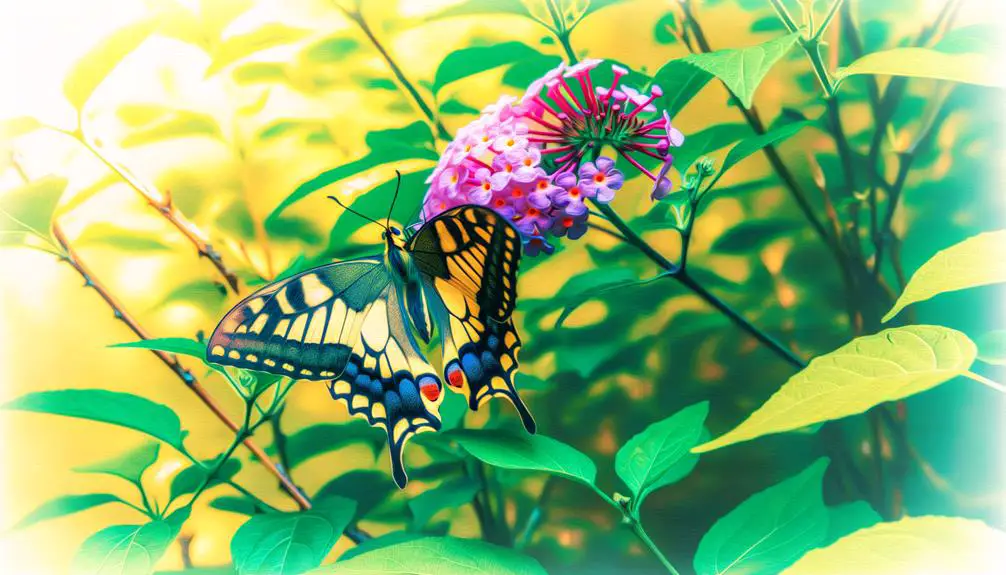
Key Takeaways
- Swallowtail butterflies exhibit striking wing patterns and tail-like extensions.
- *Papilio machaon*, known as the Old World Swallowtail, is a prominent species.
- The vibrant colors and unique morphological features aid in predator evasion.
- Macro photography captures intricate details like wing veins and antennal structures.
Understanding Swallowtail Butterflies
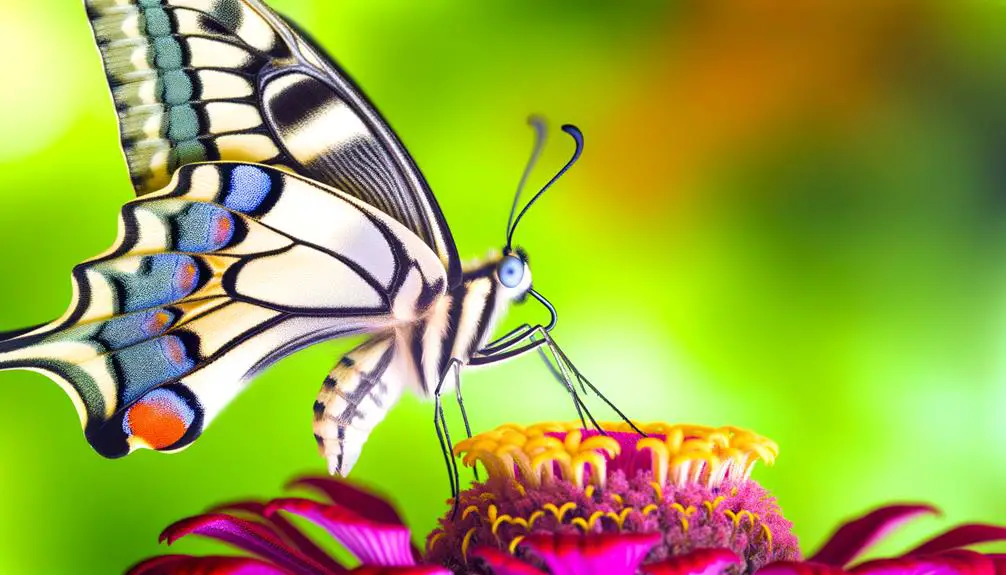
Swallowtail butterflies, belonging to the family Papilionidae, are characterized by their striking wing patterns and unique tail-like extensions on their hindwings. These morphological features are not merely aesthetic; they play essential roles in survival, including predator evasion and mating rituals.
Papilionidae encompasses approximately 550 species, displaying diverse coloration and patterns, often involving iridescent scales and eye spots. Notable genera within this family include *Papilio*, *Graphium*, and *Pterourus*.
Detailed observations reveal that these butterflies exhibit complex behaviors such as mud-puddling, where they extract nutrients from moist substrates. The caterpillars, often adorned with eye-like patterns, possess osmeteria, specialized organs used for defense.
Understanding these intricate characteristics offers insights into their evolutionary success and ecological significance.
Types of Swallowtail Butterflies
Building upon the understanding of their distinctive morphological features and behaviors, it is pertinent to explore the diverse types of swallowtail butterflies, which are classified into various genera such as *Papilio*, *Graphium*, and *Pterourus*, each demonstrating unique adaptations and geographical distributions.
The genus *Papilio* includes the well-known *Papilio machaon* (Old World Swallowtail), noted for its wide range across Europe and Asia.
*Graphium* species, such as *Graphium agamemnon* (Tailed Jay), exhibit swift flight and are mainly tropical.
The *Pterourus* genus, including *Pterourus glaucus* (Eastern Tiger Swallowtail), is prominent in North America, showcasing striking yellow and black coloration.
These genera illustrate the evolutionary diversity and ecological niches occupied by swallowtail butterflies worldwide.
Habitat and Behavior
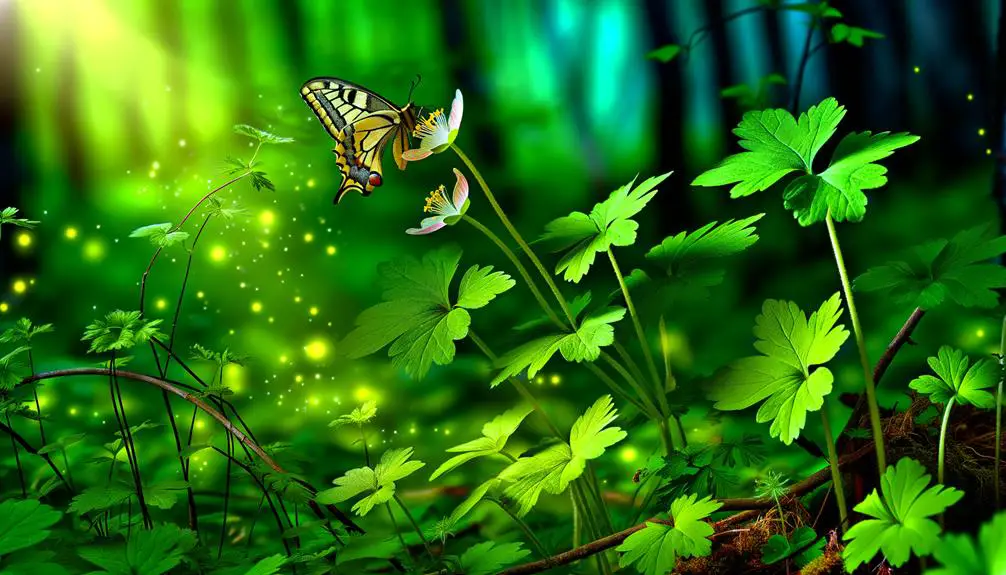
The diverse habitats occupied by swallowtail butterflies, ranging from tropical rainforests to temperate woodlands, profoundly influence their behavioral ecology and life cycle dynamics. These environments dictate the availability of host plants for larvae, which are critical for their development. Swallowtails (family Papilionidae) exhibit territorial behavior, often engaging in intricate flight patterns to deter rivals. Migration patterns vary, with some species displaying long-distance travel to find ideal breeding grounds. Pollination activities also play a significant role in their ecological interactions.
| Habitat Type | Key Behaviors |
|---|---|
| Tropical Rainforests | High species diversity, host-plant specificity |
| Temperate Woodlands | Migration, territorial disputes |
| Grasslands | Larval feeding on herbaceous plants |
| Urban Gardens | Adaptation to human-modified landscapes |
Understanding these dynamics is essential for conservation efforts and biodiversity management.
Equipment for Butterfly Photography
Capturing high-quality images of Papilionidae requires meticulous selection of photographic equipment, including a macro lens to achieve fine detail and clarity.
Ideal lighting conditions, ideally natural light during early morning or late afternoon, are vital for reducing harsh shadows and achieving true color representation.
Additionally, the use of a tripod and other stabilization tools is essential to minimize camera shake, ensuring sharp and precise images of these agile lepidopterans.
Camera and Lens Selection
Selecting the appropriate camera and lens is vital for effectively capturing the intricate details and vivid colors of Swallowtail butterflies (Papilionidae).
For ideal results, a DSLR or mirrorless camera with a high-resolution sensor is recommended to achieve sharp, detailed images.
Macro lenses, particularly those in the 90-105mm range, provide the necessary magnification and working distance to photograph these lepidopterans without disturbing them.
Features such as image stabilization and fast autofocus are essential for tracking the butterflies' erratic flight patterns.
Additionally, a telephoto lens with a focal length of 200-400mm can be advantageous for capturing Swallowtails in their natural habitats, allowing photographers to maintain a respectful distance while still obtaining clear, vibrant shots of these exquisite specimens.
Ideal Lighting Conditions
While a well-chosen camera and lens are fundamental, ideal lighting conditions are equally paramount for accentuating the intricate patterns and colors of Swallowtail butterflies (Papilionidae).
To achieve peak illumination, natural light is most effective, particularly during the golden hours—early morning and late afternoon—when sunlight is diffused and soft. This soft light minimizes harsh shadows and highlights, revealing the detailed morphology and vibrant hues characteristic of the Papilio genus.
Additionally, reflectors can be employed to direct ambient light onto shaded areas, enhancing visibility of delicate wing structures.
For controlled environments, continuous LED lights with adjustable intensity and color temperature can simulate natural conditions, ensuring consistent and accurate representation of the butterfly's exquisite phenotypic traits.
Tripod and Stabilization Tools
To achieve ideal image sharpness and prevent motion blur when photographing the delicate Swallowtail butterflies, employing a sturdy tripod or other stabilization tools is vital in maintaining camera stability.
The use of a high-quality tripod minimizes vibrations, allowing for precise capture of Papilio machaon, especially in low-light conditions where slower shutter speeds are necessary.
Alternatively, monopods or gimbal heads offer flexibility and mobility, catering to the unpredictable flight patterns of these Lepidopterans.
These stabilization tools are particularly beneficial when focusing on the intricate wing patterns and coloration that characterize the Papilionidae family.
Advanced stabilization techniques guarantee that the ethereal beauty of Swallowtails is captured with the utmost clarity, enabling photographers to produce sharp, high-resolution images that resonate with their quest for artistic freedom.
Best Times for Photos
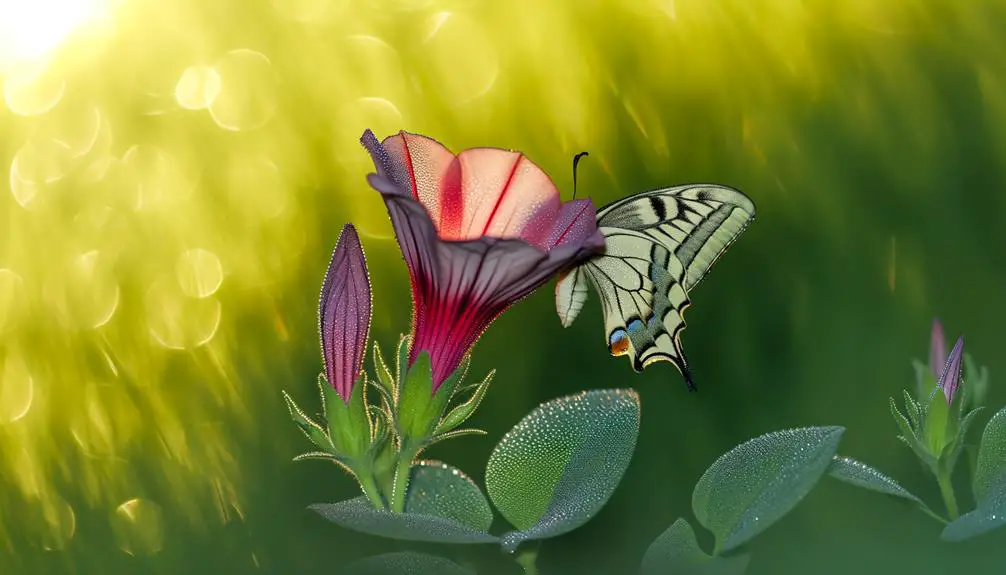
Ideal photography of the Swallowtail Butterfly (Papilionidae) is typically achieved during the early morning or late afternoon when these diurnal insects exhibit increased activity and the natural light conditions are most favorable. During these times, the angle of sunlight provides softer illumination, reducing harsh shadows and enhancing the vivid coloration of the butterfly's wings. Observations indicate that Swallowtails are particularly photogenic when they are nectaring on flowers or basking in sunlight to regulate their body temperature.
| Time of Day | Benefits |
|---|---|
| Early Morning | Increased activity, soft light |
| Late Afternoon | Best lighting, calm behavior |
| Midday | Harsh shadows, less active |
| Overcast Days | Diffused light, good detail |
| Evening | Reduced activity, low light |
Photographers should capitalize on these periods to capture exquisite details.
Techniques for Capturing Flight
Capturing the Swallowtail Butterfly in flight requires mastery of both camera settings and an understanding of the butterfly's behavior patterns.
Swallowtails (Papilionidae) exhibit erratic flight movements, necessitating high shutter speeds to freeze motion effectively. Ideal settings include:
- Fast Shutter Speed: 1/2000s or higher to capture rapid wing beats.
- Continuous Autofocus: Guarantees sharpness as the butterfly changes direction.
- High ISO Sensitivity: Maintains exposure without compromising depth of field.
Understanding diurnal activity patterns and preferred nectar sources of species, such as Papilio machaon and Papilio polyxenes, enhances the likelihood of successful captures.
Patience, practice, and precise adjustments are key to photographing these enchanting insects in their natural habitats.
Post-Processing Tips
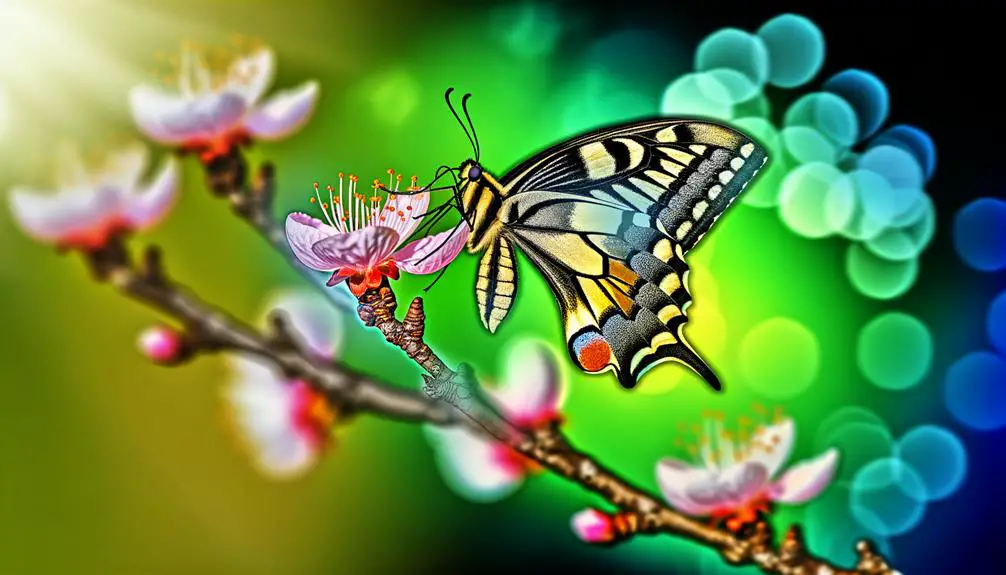
Post-processing is vital for accentuating the distinctive features of Papilio machaon, particularly in enhancing color vibrancy to highlight the species' vivid wing patterns.
Adjusting image sharpness is essential for emphasizing the intricate details of the butterfly's morphology, such as the venation and scale structure.
Additionally, precise cropping for composition guarantees that the subject remains the focal point, facilitating a clear and impactful visual presentation.
Enhancing Color Vibrancy
To amplify the color vibrancy in images of the Papilio machaon, precise adjustments in saturation, contrast, and hue during post-processing can greatly enhance the visual representation of this lepidopteran species.
By fine-tuning these parameters, photographers can highlight the intricate wing patterns and iridescent hues characteristic of the Swallowtail butterfly. This level of control allows for stunning close-up shots that showcase the butterfly’s delicate details with remarkable clarity. For digital artists seeking inspiration, a free Swallowtail butterfly vector can serve as a useful reference for capturing the butterfly’s graceful form. Whether through photography or digital design, these visual representations celebrate the natural beauty of this remarkable species.
- Saturation: Intensify the colors to make the butterfly's patterns more vivid.
- Contrast: Adjust to enhance the dynamic range between the lighter and darker areas of the wings.
- Hue: Shift the color balance slightly to achieve a more natural or artistically desired appearance.
These techniques guarantee an accurate yet striking depiction, capturing the essence of Papilio machaon's natural splendor.
Adjusting Image Sharpness
Enhancing image sharpness is essential for accentuating the intricate details of the Papilio machaon's wing morphology, providing a clearer visual study of its taxonomic characteristics.
Employing high-pass filters and unsharp mask techniques can reveal the fine venation patterns and iridescent scales, vital for distinguishing subspecies within the Papilionidae family.
Adjustments should be meticulously calibrated to avoid artifacts that could obscure the diagnostic features, such as the caudal extensions and eye spots.
Utilizing advanced software tools, such as Adobe Lightroom or Capture One, allows for precise control over sharpening parameters, ensuring that the edges are enhanced without oversaturation.
This meticulous attention to detail is paramount for entomologists and lepidopterists seeking to document and analyze the Swallowtail butterfly with scientific accuracy.
Cropping for Composition
How can the strategic cropping of images maximize the visual impact and scientific value of the Papilio machaon's morphological features?
Cropping is pivotal in emphasizing key characteristics such as wing patterns, coloration, and structural details, thereby enhancing both aesthetic appeal and taxonomic clarity. By isolating specific elements, one can draw attention to diagnostic markers critical for species identification.
- Highlighting Wing Veins: Focus on the intricate venation for morphological studies.
- Emphasizing Coloration: Accentuate vibrant hues that distinguish Papilio machaon from similar taxa.
- Framing Antennal Structures: Capture the detailed morphology of the antennae for taxonomic precision.
This meticulous approach aids in both scientific documentation and artistic presentation.
Showcasing Your Photos
When displaying your photographs of Papilio machaon, consider the use of macro photography to highlight the intricate patterns and vivid colors characteristic of this swallowtail butterfly species. Employing close-up techniques can emphasize the delicate wing structures and the striking chromatic contrasts.
The following table illustrates the details to focus on for an evocative portrayal:
| Feature | Description |
|---|---|
| Wing Patterns | Intricate, eye-catching motifs that enhance visual appeal. |
| Coloration | Vivid yellows, blacks, and blues that captivate the observer. |
| Antennae | Filamentous structures aiding in sensory perception. |
| Proboscis | Coiled feeding apparatus, a marvel of evolutionary adaptation. |
| Habitat Context | Background elements that showcase the butterfly's natural setting. |
These aspects not only elevate the aesthetic quality but also provide insight into the species' taxonomic distinctions.
Conclusion
To conclude, the study of swallowtail butterflies (Papilionidae) reveals remarkable diversity and distinctive behaviors, flourishing in varied habitats.
Advanced apparatus and adept techniques are essential for capturing these agile insects in flight. Ideal opportunities for photography occur in early morning or late afternoon.
Post-processing practices enhance image clarity and color accuracy, ensuring vivid visuals.
Displaying meticulously documented photographs promotes appreciation and understanding of these dynamic, delicate creatures within the scientific community and beyond.

